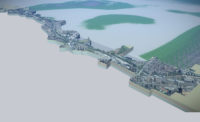Three Runways Open But New Streamlined Rules Stall
As three new U.S. runways officially opened Nov. 20, the Federal Aviation Administration bill that would fund airport improvement grants, which would include a more streamlined process for future runway projects, still awaits reauthorization.
The runways, opening at Washington Dulles, Chicago O’Hare and Seattle-Tacoma airports, will allow for 300,000 more flights nationwide annually, says FAA Acting Administrator Robert Sturgell. Nevertheless, a May 2007 FAA report identifies 14 airports that will soon face capacity constraints unless more new runways or new airports are built.
FAA’s efforts to streamline the project-approval process have been hurt by the wait for reauthorization, says Sturgell. “The continuing resolutions in the past several years have also hurt,” he says. “Last year we couldn’t send grants to airports until well into the fiscal year, so some projects slowed down. Folks are saying we could see a reauthorization bill in late spring. It really depends on the new administration.”
Greg Principato, president of Airports Council International-North America (ACI-NA), says raising passenger facility charges “would do an awful lot to get airfield projects online a lot quicker.” PFCs are currently capped at $4.50 but many want that to rise to $7. ACI-NA is also asking Congress to relieve the tax burden on airport bonds.
Jim Thomson, Seattle-based project manager for HNTB Corp., has worked on the design of Seattle-Tacoma airport’s new runway since 1996. “I don’t know how much the process has changed, or if we’ve changed with the process,” he says. “Back when this started, we knew the environmental regulations, but maybe we didn’t know the most efficient way to get through them.” Engineers can no longer focus only on technical elements. “Now you have to look at it more broadly, including the environmental components,” he says.
Sturgell says the next big runway projects due are an extension at Philadelphia and a new runway at Charlotte-Douglas International Airport.


